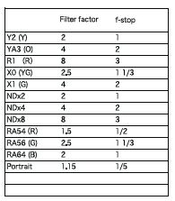skylight1b
Member
I'm not sure which forum this should go in, and I feel like it's the stupidest question, but I would like to know the definitive answer on what the EV compensation and/or filter factor is for the Hoya X0 yellow-green filter.
Hoya's documentation says the necessary compensation is either 1/4 stop or 1.5 stops depending on which of their sites you reference. The chart on the back of my Hoya orange YA3 filter (X0 doesn't have one) says the X0 filter needs 1 1/3 stops compensation. In my own online research, I have seen anywhere from 1/4 to 2 stops. I actually own this filter and have used it, but I can't figure out the answer. My guess is somewhere on the lower end but not really sure.
So for those of you who own this exact filter (not another yellow-green), how many stops should one add? I know it will vary on the film being used, but 1/4 to 2 stops is a huge range.
Hoya's documentation says the necessary compensation is either 1/4 stop or 1.5 stops depending on which of their sites you reference. The chart on the back of my Hoya orange YA3 filter (X0 doesn't have one) says the X0 filter needs 1 1/3 stops compensation. In my own online research, I have seen anywhere from 1/4 to 2 stops. I actually own this filter and have used it, but I can't figure out the answer. My guess is somewhere on the lower end but not really sure.
So for those of you who own this exact filter (not another yellow-green), how many stops should one add? I know it will vary on the film being used, but 1/4 to 2 stops is a huge range.














